The Wild Weather Book
Air Date: Week of May 17, 2013
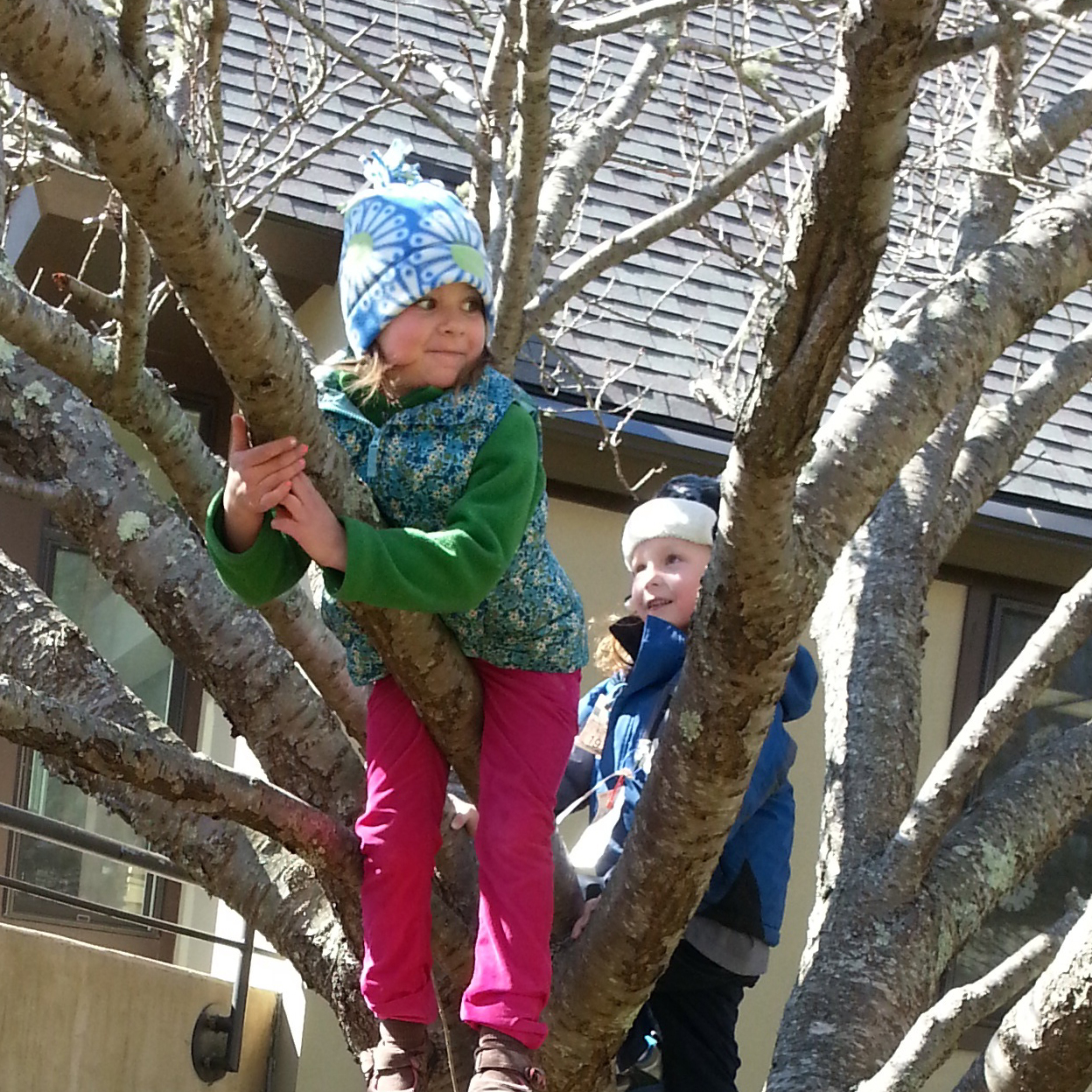
From up here we can see our wind chime really well. (Naomi Arenberg)
Why stay indoors just because of rain, wind, snow, or ice? A new book, The Wild Weather Book, by Fiona Danks and Jo Scholfield, details activities to get children outside in all sorts of weather. Recently some elementary school students in Massachusetts tested a couple of the projects and Naomi Arenberg joined them.
Transcript
CURWOOD: It's Living On Earth, I'm Steve Curwood.
“Imagine jumping in the biggest puddle you can find, or playing barefoot and feeling squidgy mud ooze up between your toes. How about letting the wind push you along? There’s no need to stay cooped up when it’s wet, windy or cold…”
That’s the introduction to The Wild Weather Book: Loads Of Things To Do Outdoors In Rain, Wind and Snow. It’s a sort of recipe book by Fiona Danks and Jo Schofield describing activities that require little more than the right weather and a child’s imagination. Recently a teacher in southeastern Massachusetts got his after-school contingent ‘cooking’ with some ideas from the book - and Naomi Arenberg put on her waders to go check it out as well.
ARENBERG: School is out at Friends Academy in Dartmouth, Massachusetts. Cross-legged on the library floor, it’s me and five kids.
ZEKE: Zeke.
KAZIMIR: Kazamir.
OSTA: Osta.
CHLOE: Chloe, .
FRANKIE: Frankie.
ZINE: And Mr. Zine.
ARENBERG: That’s Peter Zine, the teacher in charge of these first- and second-graders.
ZINE: And so, guys, today we’re gonna be using this book. It’s called “The Wild Weather Book: Loads of Things To Do Outdoors In the Rain, Wind, and Snow.” What type of wild weather do we have today, do you think?
KID: Wind.
ZINE: Wind, definitely. So we’re gonna do some activities that utilize the wind, that will allow us to build stuff and have some fun outside. So guess what we’re gonna do first. We are going to do an activity, which makes music…with cooking stuff.
(KIDS COMMENT AS ZINE TAKES UTENSILS OUT OF BAG.)
ZINE: So look at this, look at this picture.
ARENBERG: The kids lean in close to examine a photo of children hanging kitchen utensils on a tree in the wind.
ZINE: You guys see that picture? So here’s what we’re going to do. Listen to this. “Raid the kitchen for whisks, wooden spoons, skewers, pan lids and anything else you can find that might make a noise. Try banging them together to see what different sounds you can make, and then choose some to hang along a stick.” So we’re going figure out how to make a wind chime out of all this stuff. Whad’you guys say, we go outside?
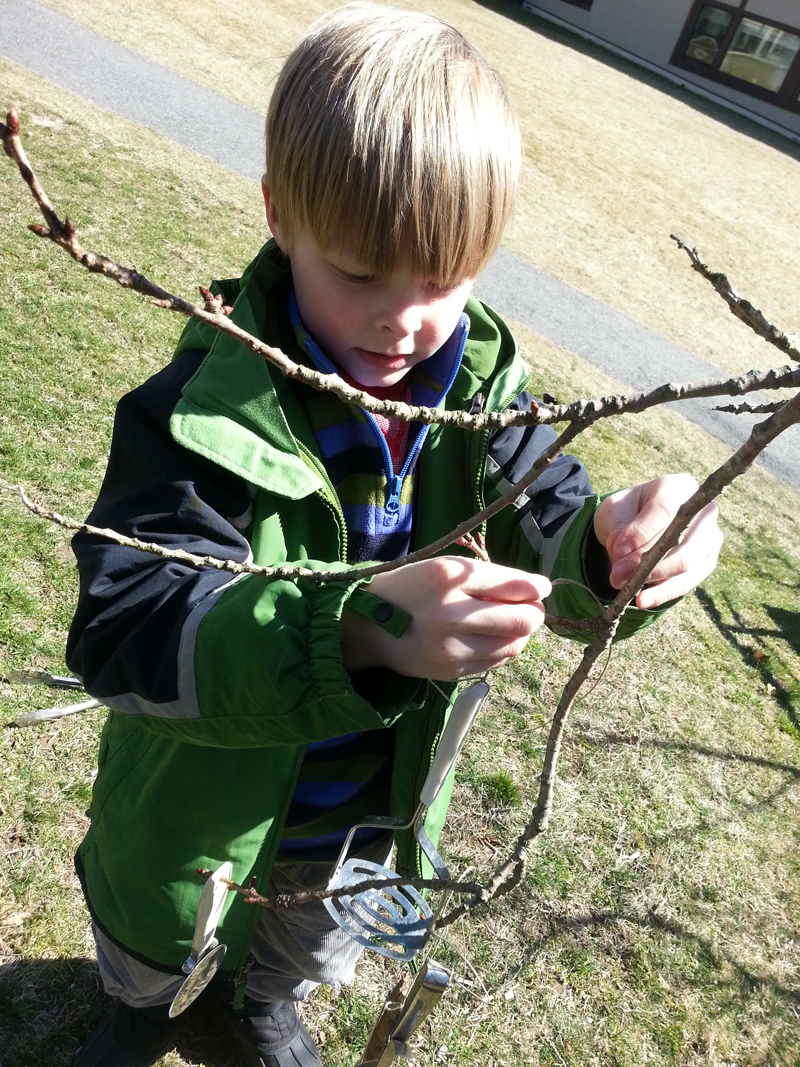
Kaz positions the potato masher. (Naomi Arenberg)
KIDS: Yeah
ZINE: Make something?
KIDS: Yeah!
ZINE: All right, bundle up.
ARENBERG: It’s a short walk to the open space behind the school, where there’s an enormous copper beech as well as a few young trees. The children grab spatulas and salad tongs and bang them together to test the sounds, and then look around for the best tree.
ZINE: What tree do you think we should use?
KIDS: That one! That one has really strong branches.
KID: In background: Easy-peezy, lemon-squeezy.
ZINE: How are we gonna do this? Does anyone have a plan?
KID: I do!
ARENBERG: The boys explain their construction schemes, but a couple of the girls are experimenting with their pizza cutters and kitchen shears.
KIDS: I’ll help clip the grass. She’s clipping the grass.
ZINE: These tools do more than just kitchen work, huh? We could landscape.
KIDS: She’s cutting the grass. I’m clipping it.
ARENBERG: They trim the lawn for a bit, then return to their chosen tree. Soon these six and seven-year-olds are lacing string through the holes on spatula handles, tying knots, and arranging their music makers on a low branch.
ZINE: Very cool, Frankie!
ARENBERG: Oh, wow, you’ve got three on there!
ARENBERG: And the kids find even more uses for the utensils. A pair of tongs with a hole at the top can turn into a telescope.
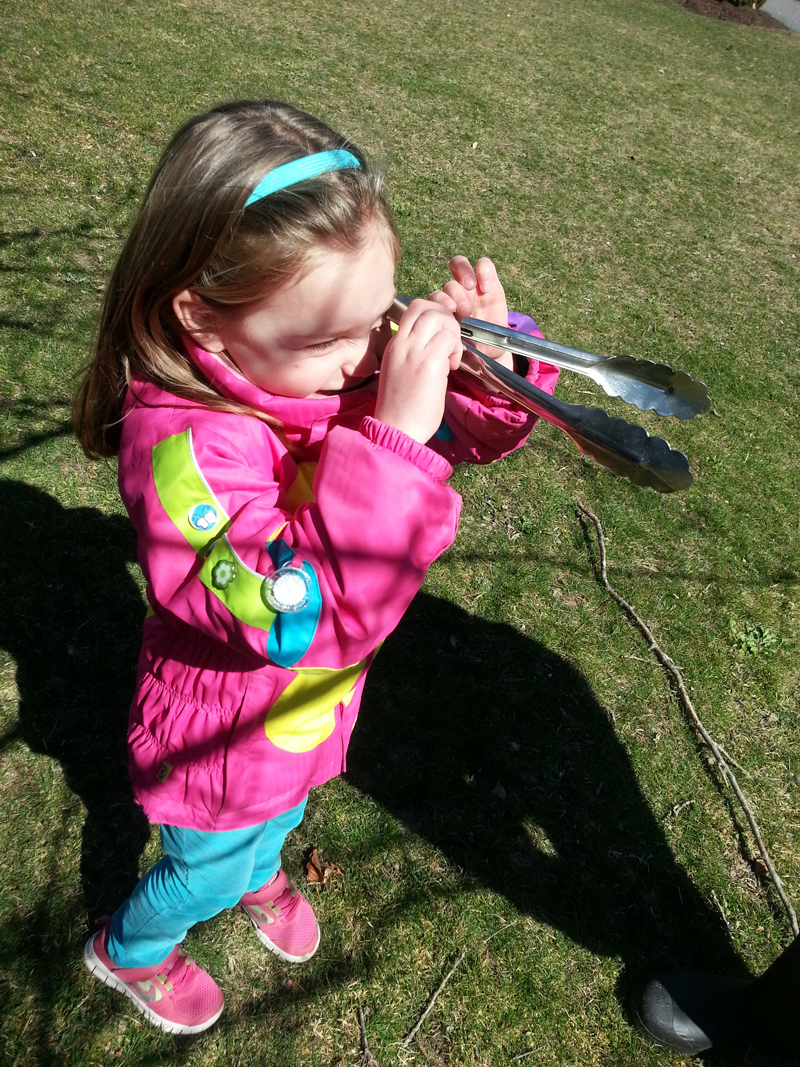
With a little imagination tongs can turn into a telescope. (Naomi Arenberg)
ARENBERG: (LAUGHS) I need a photo of you doing that. Can one of you look through there?
ZINE: Yeah, why don’t you hold it up? Hey, guys, why don’t you come down and see what’s going on over here?
KID: I can see from up here.
ZINE: You have a good vantage point there, Frankie?
KID: Yup.
KID: Wow, that looks pretty nice.
ARENBERG: So, which utensils are hitting each other and making noises?
KIDS: OK, so this is a potato masher. Pizza cutter. Spatulas. Whatever this thing is. I don’t know. Maybe a salad scooper or something?
ARENBERG: Good for you!
KID: The pizza cutter is also something that Osta uses to cut grass…Check out this bug I found.
ZINE: Girls, come over here for a minute and let’s see if we can hear our wind chime.
KID: There’s not much…(CHIMES GO CRAZY.)…A little too much…
ZINE: I think this is a pretty cool wind chime. What do you think?
KIDS: Yeah…yeah…yeah…yeah…
ARENBERG: With the wind chime finished some of the kids wander off to the lawn.
KIDS: It’s sprouting! Soon we’ll have our very own maple tree right here. Yay!
ARENBERG: Did you guys plant that or did you find it?
KIDS: We just found it!! (CHIMES CLANGING.) It has to grow big and fat, so…(CHIMES CLANGING)…
ARENBERG: Maybe someday you guys will come back when the tree is big enough for you to build a wind chime on it.
KIDS: Yay! - Hey, hey, don’t pick it! - I’m not! - And don’t put a leaf on it.
ARENBERG: As Peter Zine is packing up his string, the kids hum along with their wind chime.
ZINE: He’s trying to make the same sound as the wind chime. Do you want to try it out?
KID: OK.
(GENTLE HUMMING, THEN BURSTS OF LAUGHTER.)
KID: Frankie!
KID: I’m not good at making sounds.
(MORE LAUGHTER.)
ZINE: Aw’right, guys, say “bye” to your windchime.
KIDS: Bye, windchime. Bye, little plant…
ZINE: Say ’bye to your little tree friend. And I want to show you something very cool, and then we’ll try to think about how we can make boats.
ARENBERG: We head down a grassy slope, toward the trees and a vernal pool. As soon as we’re in the woods, the kids notice a strange sound.
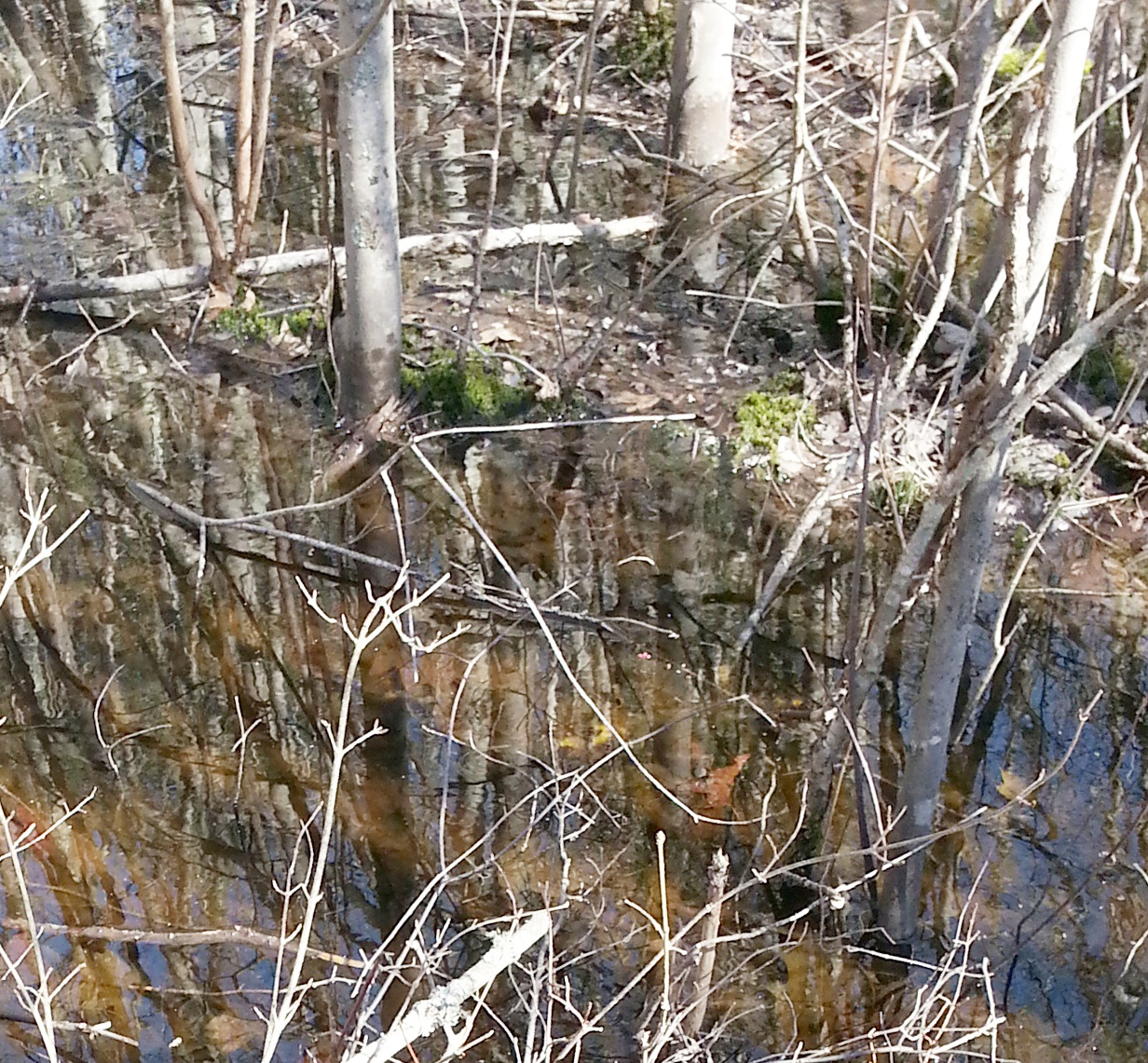
We sailed our boats in this vernal pool. (Naomi Arenberg)
(DISTANT WOOD FROGS CROAKING)
KID: What’s that…?
ZINE: What’s that sound?
KID: It’s creeper…ribbet, ribbet, ribbet, ribbet, ribbet, ribbet…
ZINE: Wood frogs… Sound like ducks, don’t they?
KID: Sound like ducks.
ZINE: So, if you guys want to wait here, I’m gonna go in the, I’m gonna go in and grab some for ya’.
ARENBERG: Peter Zine wades into the water and collects some wood-frog eggs in a plastic tub.
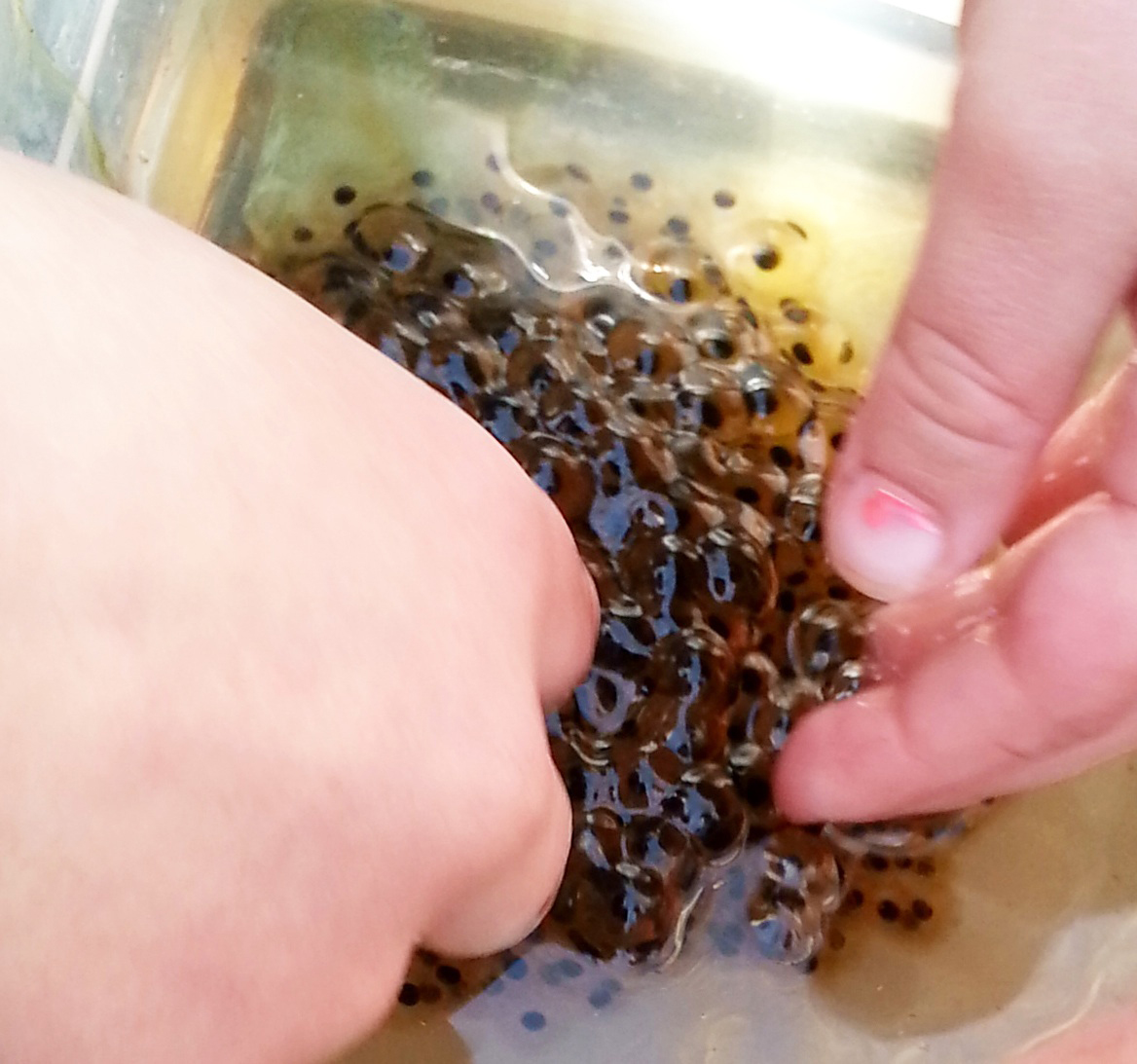
Everyone got to pick up the wood-frog eggs. (Naomi Arenberg)
(SOUNDS OF SPLASHING)
KIDS: I, I knew it! Can I touch it? Eeee-ooo. Ugh!
ZINE: What does it feel like?
KIDS: They feel like jello. (LAUGH). They feel gross! Tadpoles growing inside ‘em. Oooch. Don’t pop ’em! Do not pop ’em!
ZINE, Frankie, wanna try and pick it up, Frankie?
FRANKIE: Ok
ZINE: Whad’ya think?
FRANKIE: Cool.
ZINE: Don’t break ’em up…There we go, we’ll keep ’em together…You wanna say ’bye to the frogs?
KID: ’Bye, little frogs.
ARENBERG: The kids find everything interesting – frog spawn, fox tracks, fallen trees. It’s not clear whether they’ll focus on making boats out of twigs and leaves, the way those smiling children in the book did, but their teacher sounds confident.
ZINE: So, we’re gonna try to make a boat. What do you think we can use? Because we don’t have materials for this one. I didn’t get anything. Zeke, what’s your idea? Zeke is raising his hand. We’re gonna ask Zeke what he thinks.
ZEKE: This could be like the sail. It could go like this. To make the boat go.
ZINE: Excellent. So let’s, let’s gather some materials for making a boat. Use your imaginations.
ARENBERG: The five boat-makers set off, eyes trained on the ground, skirting the pool’s edge.
(CHATTER –“IT IS SORT OF DEEP…BUT I’LL GO THROUGH…YOU NEED SOME STRING?”)
KAZIMIR: My feet are way under this mucky water, and I’m looking for like a good leaf…
ZINE: Hey, Kaz, Zeke has an idea, but he would like some help tying. Do you think you could help him out? (SPLASHING.)
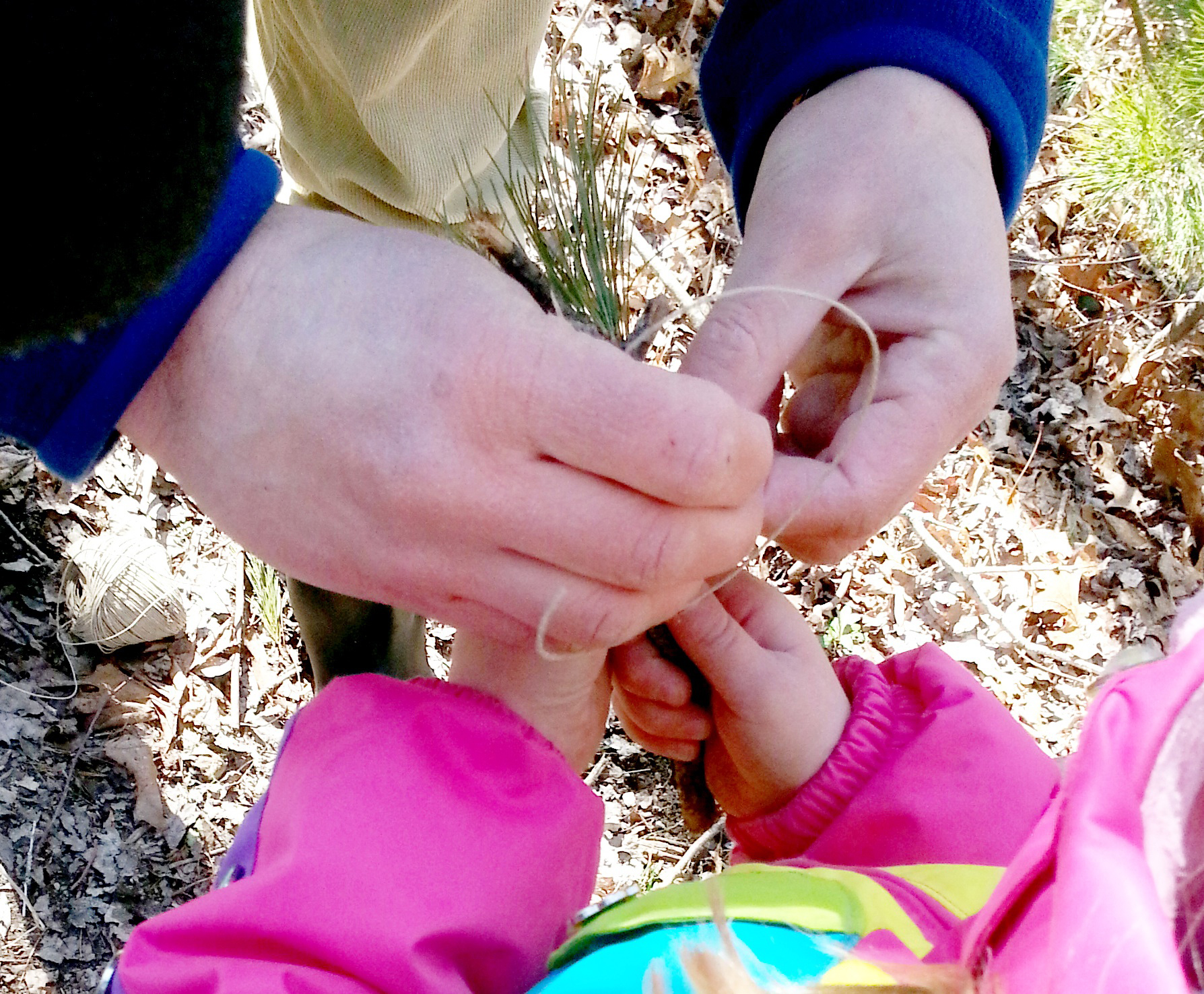
Tying pine needles to twigs takes two pairs of hands. (Naomi Arenberg)
ARENBERG: There’s plenty of string. Still, it’s tricky to figure out how to tie leaves or pine needles onto twigs or bark.
KID: This is hard.
ZINE: Maybe get down low…
KID: Could you help us?
ZINE I would love to help you. Yeah.
KID: I’ll go back into the water.
KID: I don’t care if I get my jeans messy.
KID: This does not float, though.
ZINE: (CHUCKLES.) How come?
ARENBERG: And even if the boats float, you could face other problems.
ZEKE: But then how could we try it out when there’s like so deep water?
ZINE: That’s a good question. What do you think we’ll do?
KID: And how do you do it, like, to pull it back?
ZINE: Ah, that’s a really good question.
KID: You could use a string…attach a string to it...yuh, yuh, yuh…then you could pull it back.
ZINE: Hey, Kaz, let’s try not to get too much water IN your boots. OK, bud? Try not to poke anybody in the eye with that.
ARENBERG: Despite the challenges, all the kids have gathered leaves, twigs, moss, pine needles, bark, maybe a bit of mud, and designed a very small watercraft.
KID: I have a very thin piece of wood for the bottom. I have a holly leaf for the sail, and I have tuh- three twigs for the edges.
KID: Don’t tie my finger on!
ZINE: No. (Chuckles)
KID: I hope my boat works!
KID: This is hard.
KID: It floats! Now, that is a good boat…OK, (GRUNT) …Grab it back out of the water…I don’t think we’ll need those…Some sticks are falling off.
ARENBERG: And with that successful launch, it’s time to gather up all of the boats, the string, the wild weather book, assorted coats and hats, and trek back up the hill to the school building. I hope that everyone had a good time, but it’s hard to tell. Then Kaz speaks up.
KID: That was really fun. Are we gonna do any more?
ARENBERG: I would, but I think your parents might be here to pick you up. What was your favorite part of what we did outdoors, of all the things we did outdoors?
KID1: Touch the frog spawn.
KID2: Mmm…I liked everything.
ARENBERG: As for Peter Zine, the teacher…
ZINE: Anything that encourages youth to get outside…I love that, that message that the book sends, that just because it’s wet outside or windy, that we don’t have to retreat indoors, that, you know, there’s still a lot of fun things to do outside.
ARENBERG: I love the way they were showing off their boats.
ZINE: (CHUCKLES.) Yeah, they were quite proud. They didn’t need to be too complicated. The smallest ideas, used big in imagination, so the kids had a lot of fun creating those boats. Yeah.
ARENBERG: And maybe that’s the essential message of a book like this – that any activity can launch kids’ imagination, creativity, and discoveries. And perhaps a maple sapling will sprout up behind Friends’ Academy, where Chloe, Frankie, Kaz, Osta, and Zeke were the first to notice it.
For Living on Earth, I’m Naomi Arenberg in Dartmouth, Massachusetts.
Links
Living on Earth wants to hear from you!
Living on Earth
62 Calef Highway, Suite 212
Lee, NH 03861
Telephone: 617-287-4121
E-mail: comments@loe.org
Newsletter [Click here]
Donate to Living on Earth!
Living on Earth is an independent media program and relies entirely on contributions from listeners and institutions supporting public service. Please donate now to preserve an independent environmental voice.
NewsletterLiving on Earth offers a weekly delivery of the show's rundown to your mailbox. Sign up for our newsletter today!
 Sailors For The Sea: Be the change you want to sea.
Sailors For The Sea: Be the change you want to sea.
 The Grantham Foundation for the Protection of the Environment: Committed to protecting and improving the health of the global environment.
The Grantham Foundation for the Protection of the Environment: Committed to protecting and improving the health of the global environment.
 Contribute to Living on Earth and receive, as our gift to you, an archival print of one of Mark Seth Lender's extraordinary wildlife photographs. Follow the link to see Mark's current collection of photographs.
Contribute to Living on Earth and receive, as our gift to you, an archival print of one of Mark Seth Lender's extraordinary wildlife photographs. Follow the link to see Mark's current collection of photographs.
 Buy a signed copy of Mark Seth Lender's book Smeagull the Seagull & support Living on Earth
Buy a signed copy of Mark Seth Lender's book Smeagull the Seagull & support Living on Earth

